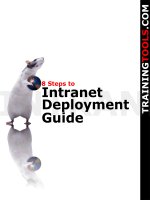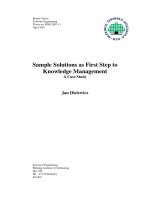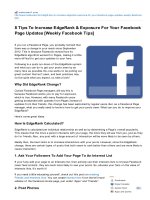8 step to Intranet development guide_144
Bạn đang xem bản rút gọn của tài liệu. Xem và tải ngay bản đầy đủ của tài liệu tại đây (549.72 KB, 29 trang )
Share these FREE Courses!
Why stuff your friend’s mailbox with a copy of this when we can do it for you!
Just e-mail them the link info –
Make sure that you visit the site as well:
• MORE FREE COURSES
• Weekly Tool Tips
• Updated course versions
• New courses added regularly
So don’t copy files or photocopy - Share!
End User License Agreement
Use of this package is governed by the following terms:
A. License
TrainingTools.com Inc, ("we", "us" or "our"), provides the Licensee ("you" or "your") with a set of digital files in electronic format (together
called "the Package") and grants to you a license to use the Package in accordance with the terms of this Agreement. Use of the package
includes the right to print a single copy for personal use.
B. Intellectual Property
Ownership of the copyright, trademark and all other rights, title and interest in the Package, as well as any copies, derivative works (if any
are permitted) or merged portions made from the Package shall at all times remain with us or licensors to us. This Package is protected by
local and international intellectual property laws, which apply but are not limited to our copyright and trademark rights, and by international
treaty provisions.
C. Single-User License Restrictions
1. You may not make copies of the files provided in the Package
2. You may not translate and/or reproduce the files in digital or print format
3. You may not rent, lease, assign or transfer the Package or any portion thereof
4. You may not modify the courseware
Copyrights and Trademarks
No part of this document may be reproduced, stored in a retrieval system, or
transmitted in any form or by any means – electronic, mechanical, recording, or
otherwise – without the prior written consent of the publisher.
Netscape Navigator is a trademark of Netscape Communications Corp.
Windows 3.1, Windows 95, Windows NT, and Internet Explorer are trademarks of
Microsoft Corporation.
All trademarks and brand names are acknowledged as belonging to their
respective owners.
Published by
XtraNet
180 Attwell Dr., Suite 130 Toronto, Ontario, Canada M9W 6A9
Phone: 416-675-1881 Fax: 416-675-9217 E-mail:
Copyright © 1999 by XtraNet
All Rights Reserved
January 1999
First Edition
1 2 3 4 5 6 7 8
Intranet Deployment Guide
OLM World Web Hosting E-commerce and Custom Internet Solutions hosting.olm.net 1
Table of Contents
Step 1: Gather Information 1
Step 2: Document Definition / Navigation Standards 2
Step 3: Publishing Paradigm 3
Step 4: Template Creation 3
Step 5: Choosing Your Tools 4
Step 6: Training 5
Step 7: Deploying the Solution 5
Step 8: Maintaining the site 5
Example Document Standard 7,8,9
Example Template 10
2 XtraNet U - The place to learn how to develop for the web -
The 8 Steps to Successful Intranet Deployment
Step 1
Gather Information
Step 1
Gather Information
Step 4
Create a Document
Standard
Step 4
Create a Document
Standard
Step 2
Implement the
Intranet Publishing
Paradigm
Step 2
Implement the
Intranet Publishing
Paradigm
Step 5
Create a
Document Template
Step 5
Create a
Document Template
Step 3
Choose your tools
Step 3
Choose your tools
Step 6
Training on the tools,
the template, and the
document standard
Step 6
Training on the tools,
the template, and the
document standard
Step 7
Deploying the
Solution
Step 7
Deploying the
Solution
Step 8
Maintaining the site
Step 8
Maintaining the site
Figure 1 Eight Steps Flow Chart
Intranet Deployment Guide
OLM World Web Hosting E-commerce and Custom Internet Solutions hosting.olm.net 3
Step 1: Gather Information
Step 1: Gather Information
Objectives:
1. Identify procedures and methods of locating information about the
business that can be improved through the deployment of an Intranet.
2. Gain an understanding of the current technologies in use within the
organization so they can be integrated into the overall plan.
3. Determine types of “Legacy Documents” that need to be converted.
Section 1.1: Identify Business Objectives, and Information for large-scale
distribution
Objective 1: identify procedures that can be streamlined in terms of time required
to complete, improving accuracy, reducing paperwork, and information updated
rapidly but is distributed slowly. Below are a list of Business Objectives that might
be helpful in determining the area that can be served best initially and create the
most return on investment.
Sample Business Objectives:
• Improved Customer Satisfaction
• Savings on operations
• Increases in revenue
• Increased Opportunities
• Time savings
• Increasing operational efficiencies
• Lowering the cost of operations
• Improved Business processes
• Profile your prospects
• Profile your customers
Sample Information for large-scale distribution:
• What are employees looking for / what do they need
- Company phonebook
- Organizational chart
• Breaking News / What’s New / Hot off the Press
• Customer service ( Internal or external Customer )
- Pre/Post Sale Information
- Research and Development Information
- Project Info – Status, Progress to Date
4 XtraNet U - The place to learn how to develop for the web -
Section 1.2: Determine Existing Technology Deployment
Objective 2: Gather Information to determine what you have in terms of existing
technology. This is useful information when we move into the later steps of the
process. It saves duplication of effort; helps align project plans and focus effort
on common goals. Below is a list of information you may want to gather about
your environment.
Network Infrastucture
• Current status with respect to the Internet
• Mail and messaging environment
• Security and Firewalls
• Transport Protocols in place
• Available bandwidth
User & Desktop
• Operating systems and standards
• Applications standards and support guidelines
• Communications and e-mail
• Browser and access restrictions
• Assess knowledge level
Section 1.3: Locate and Identify Legacy Documents
Objective 3: is to determine the type and number of existing documents that need
to be converted to a format supported on your Intranet. Below is a sample list of
information you may want to gather.
Legacy Documents
• What file formats are currently being used for
- Word-processing
- Spreadsheets
- Presentations
- Graphics
• What documents should be converted to electronic form only?
• What documents need to be converted to an electronic form and maintain a paper
copy?
• How many documents need to be converted in total?
Intranet Deployment Guide
OLM World Web Hosting E-commerce and Custom Internet Solutions hosting.olm.net 5
Step 2: Implement the Intranet Publishing Paradigm
Step 2: Implement the Intranet Publishing Paradigm
Objectives:
1. Define the Intranet Publishing Paradigm
2. Define the Information Publishing Flow
3. Define the Intranet Team. Determine who is going to fill the positions
on the team, and adjust the MBOs, or job descriptions of the people
contributing to the Intranet to include their new responsibilities.
4. Create a mission statement for the Intranet and give it a name.
Section 2.1: Intranet Publishing Paradigm
Information Storage Information Consumers
Employees with Browsers
Information Producers
Employees Creating Information
Intranet Web Servers Proxy Servers
Information Managers
(Audit & Publish)
Information Creators
(Create & Convert)
Information Creators
(Create & Convert)
Figure 2 Intranet Publishing Paradigm
The Intranet publishing paradigm describes the fundamental change occurring
within organizations today. Presently, making a document created by an
employee available to other employees is a slow process, if at all possible. The
Intranet provides a, because it allows all of the information consumers within an
organization to get to information as soon as it is published. The content creator
6 XtraNet U - The place to learn how to develop for the web -
can create a high quality document in HTML, PDF, or another approved format
for distribution.
Information / Content Creators:
• Anyone within the organization that authors documents
• May need skills upgraded
• Usually the person that owns that information
Information Manager / Content Auditor:
• Manager Level within the organization
• Business Unit Manager
• Corporate Communications Staff
• May need skills upgraded
• Audits the information for accuracy
• Will return documents to the Information Creator with revision comments.
Technical Auditor:
• Pagemasters (Highly skilled in HTML and related technologies.)
• Checks the document to make sure it fits within the document standard
• Will return documents to the Information Creator with revision comments.
Publisher / Webmaster / Site Maintainers:
• Takes documents from the Technical Auditor and publishes them to the staging server.
• Moves the content from the staging server to the production Intranet Server.
• Webmasters (usually IS staff that maintain the web servers)
Information Consumers
• Employees with browsers installed.
• There are two types, the bottom end and the high-end
• Off-line browsing and replication
Intranet Deployment Guide
OLM World Web Hosting E-commerce and Custom Internet Solutions hosting.olm.net 7
Section 2.2: Information Publishing Flow
HTML Documents
are created
Documents are
converted to
HTML
Content
Audit
Process
Information is
Consumed
Technical
Audit
Process
No
No
Yes
Yes
Information copied to
Production Server
Information is
Published to
Staging Server
Yes
No
Figure 3 Information Flow Flowchart
The "Content Auditor" position gives someone control over the "Content
Creators" content area to approve it or send it back for further revisions.
The "Technical Auditor" is someone with excellent knowledge of the document
standard (defined later) and the publishing technology. This person approves or
sends the document back for further revisions based on technical merit.
If the document passes both audits it can be published. Publishing may be a two
step process (See Information Flow diagram) in which it is first published to a
staging server to make sure all links are working and that it connects properly
with existing content. If the document is ok it is moved to the production site. If
not, it is sent back with comments for revision.
Section 2.3: Define the Intranet Team. Determine who is going to fill
the positions on the team and adjust the MBOs or job descriptions of
8 XtraNet U - The place to learn how to develop for the web -
the people contributing to the Intranet to include their new
responsibilities.
Section 2.4: Create a mission statement for the Intranet and give it a
name.









